The Complete Hakone Guide
Etiquette & Spots to Enjoy 120% of its Scenery and Culture
Table of Contents
Welcome to Hakone! How to Create a Special Trip Beyond a Simple Guide
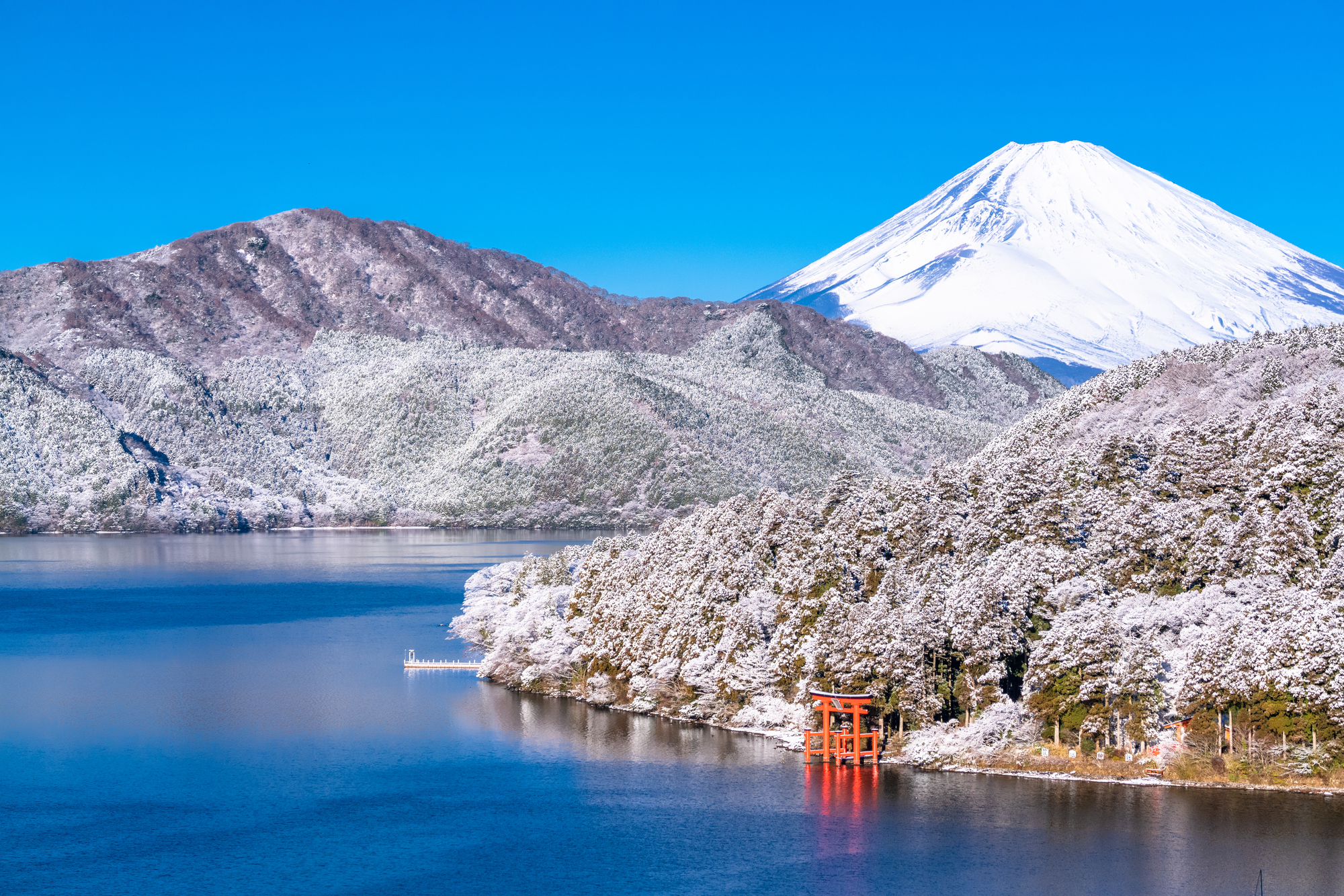
Just 90 minutes from Tokyo lies Hakone, a place of majestic nature, bubbling hot springs, world-class art museums, and breathtaking views of the sacred Mt. Fuji. For centuries, this area has healed and inspired the people of Japan.
This guide does more than just introduce Hakone's wonderful tourist spots. It's here to help you transform a typical sightseeing trip into a richer, unforgettable "experience" by deepening your understanding and respect for the beautiful local culture and customs.
Knowing a little about manners and etiquette isn't about being restricted by rigid rules. It's the magic key to making your own stay more comfortable, connecting with the locals, and creating the best possible travel memories. Let's begin your own special journey in Hakone.
1.Hakone, Loved Through the Ages: Its History, Culture, and Latest News
To truly appreciate the charm of Hakone, a shortcut is to learn about its history and culture. By imagining the steep paths that travelers of the past once crossed and experiencing the culture that continues to this day, the scenery before you will appear even more vibrant.
1-1. From "Impassable Pass" to International Resort: The History of Hakone
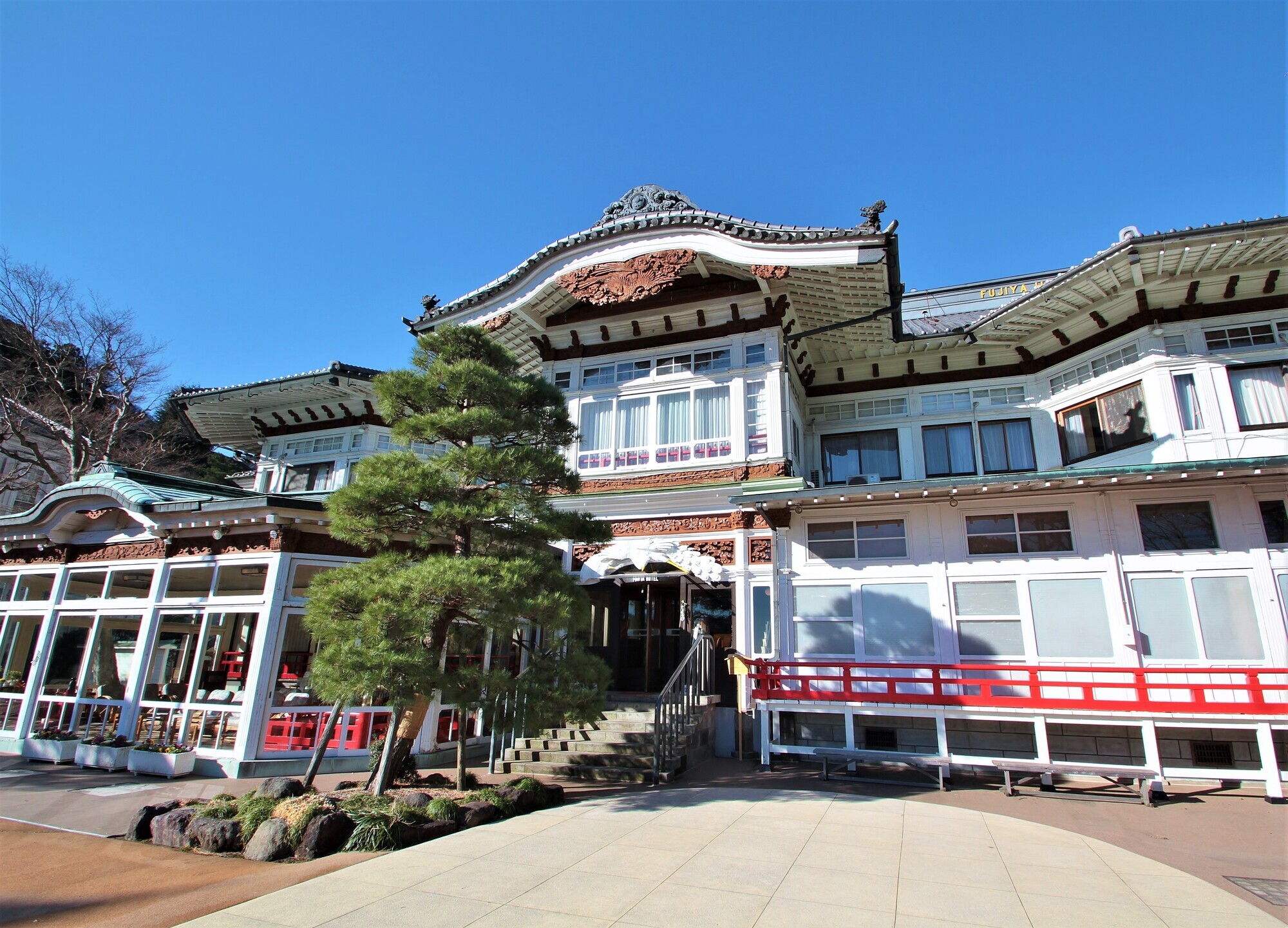
Hakone first appeared on the stage of history in the Nara period (710-794) with the founding of Hakone Shrine. However, it was during the Edo period (1603-1868) that it solidified its name. The Hakone Checkpoint was established on the Tokaido, Japan's main artery, making it a strategic point of transport. As a famous song goes, "Even horses can cross the eight leagues of Hakone, but the Oigawa River is uncrossable," the steep mountain path was known as the "impassable pass" and was the greatest challenge for travelers. Travelers of that time would rest and prepare for their next journey in the post towns of what are now Hakone-Yumoto and the Lake Ashi area.
When the checkpoint was abolished in the Meiji period (1868-1912), Hakone entered a new era. The therapeutic effects of its hot springs became known, and it gained attention as a health retreat and summer resort. The Fujiya Hotel, which opened specifically for foreign guests, attracted many wealthy foreigners and cultural figures, laying the foundation for Hakone's transformation into an international resort. In the Taisho period, the Hakone Tozan Railway opened, making it an accessible tourist destination for everyone and forming the basis of its current popularity.
1-2. Traditional Crafts and Faith: The Culture Breathing in Hakone
On a trip to Hakone, you'll have many opportunities to experience long-cherished traditions.
- Hakone Yosegi-zaiku (Marquetry): This traditional craft involves creating intricate geometric patterns using the natural colors of various types of wood. It has a long history, said to have started in Hatajuku during the late Edo period. You can find many perfect souvenirs, such as small boxes and coasters.
- Mountain Worship: Hakone has long been revered as a sacred mountain range where deities reside. At its heart is the Hakone Shrine, located on the shore of Lake Ashi. The Mototsumiya (original shrine) on the summit of Mt. Komagatake is a place to worship Mt. Kamiyama, the highest peak in the Hakone mountain range, showing that nature itself was an object of faith.
- Geisha Culture: Hakone-Yumoto is a town where geisha culture is still alive. At ryokans and hotels, you can experience traditional Japanese hospitality, including dance and parlor games.
1-3. [2025 Latest] The Ever-Evolving Spots of Hakone
While cherishing its history and traditions, Hakone is constantly evolving. Here are some noteworthy spots that have recently opened or been renovated.
- Owakudani "Chikyu no Tani" (Valley of the Earth) (Opened April 25, 2025): A new observation area has opened in Owakudani, where you can feel the breath of the Hakone volcano up close. It's packed with thrilling features, like the "Ibuki Deck" with a see-through floor, allowing you to experience the Earth's energy with all your senses.
- Hakone Komagatake Ashi no Sora (Reopened April 25, 2025): The summit area, reached by ropeway from the shore of Lake Ashi, has been reborn as a spectacular viewing spot. With net benches to lie on and giant photo frames, you can fully enjoy the panorama of Mt. Fuji and Lake Ashi.
- HAKONATURE BASE (Opened 2024): A new complex in Hakone-Yumoto. It features a pub with a craft beer brewery and a space that serves as a hub for activities, proposing new ways to enjoy Hakone.
Combining these new spots with long-standing attractions will make your trip even richer.
2.Travel Prep and Basic Info: The First Step to a Smart Journey
2-1. Access to Hakone from Tokyo
- Limited Express Romancecar (Odakyu Line): A direct trip from Shinjuku Station to Hakone-Yumoto Station in as little as 75 minutes. All seats are reserved for a comfortable journey. The observation deck seats are especially popular, so book early.
- Shinkansen (JR): Take the Shinkansen from Tokyo or Shinagawa Station to Odawara Station (about 35 minutes), then transfer to the Hakone Tozan Railway to Hakone-Yumoto Station (about 15 minutes).
- Highway Bus: There are also direct buses from Shinjuku or Tokyo Station to various areas in Hakone (Sengokuhara, Lake Ashi, etc.). Convenient if you have a lot of luggage.
2-2. Getting Around Hakone: The Rides Are Part of the Attraction
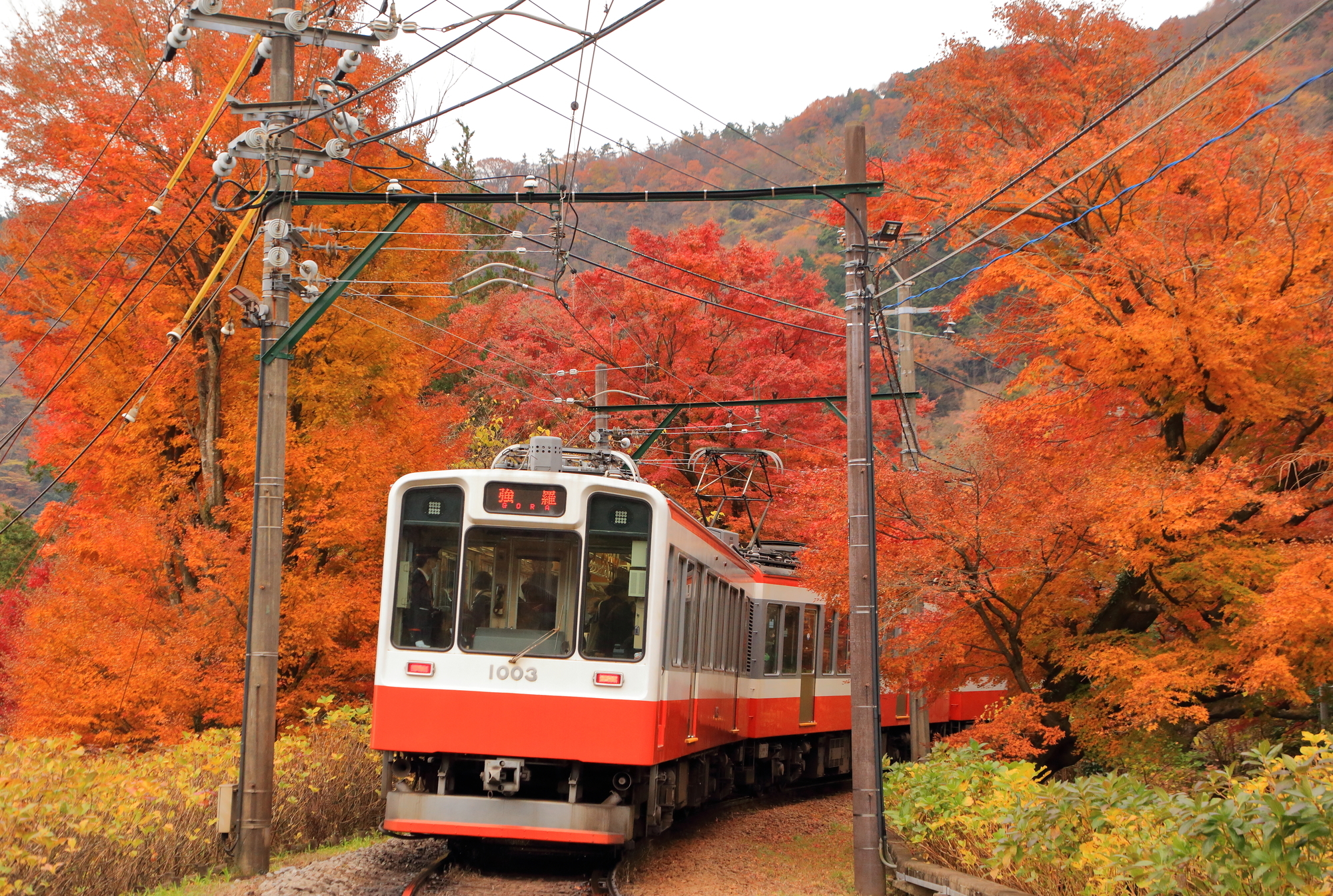
Part of Hakone's charm is touring by connecting its unique modes of transport.
- Hakone Tozan Railway: One of Japan’s leading mountain railways, which climbs steep slopes using switchbacks.
- Hakone Tozan Cablecar: Connects the steep slope from Gora Station to Sounzan Station.
- Hakone Ropeway: Connects Sounzan to Togendai via Owakudani. The views of volcanic fumes, Lake Ashi, and Mt. Fuji from the sky are breathtaking.
- Hakone Sightseeing Cruise (Pirate Ship): A gorgeous sightseeing boat that gracefully crosses Lake Ashi. Enjoy the view from the water.
- Various Buses: The bus network covers every corner of Hakone and is essential for visiting museums and smaller spots.
2-3. Your Best Friend "Hakone Free Pass": Smart Use and Tips
If you plan to tour Hakone, purchasing the "Hakone Free Pass" is highly recommended.
- What's included: Unlimited rides on the main modes of transport mentioned above (a separate fee is required for the Romancecar limited express) for a specified period (2 or 3 days), plus discounts at many tourist facilities.
- Where to buy: Available at major Odakyu Line stations like Shinjuku, Odawara Station, Hakone-Yumoto Station, etc.
- Smart use: This pass saves you the trouble of buying tickets and allows you to plan your itinerary freely without worrying about transport costs. It makes it easy to take spontaneous side trips.
- Note: Get it stamped at a ticket gate when you first use it. Show it to the staff at a manned window, not an automatic gate. Check the validity period and usable area in advance.
3.[By Area] Popular Spots and the Etiquette You Should Know
Hakone-Yumoto Area: How to Walk Through the Onsen Town and Street Food Etiquette
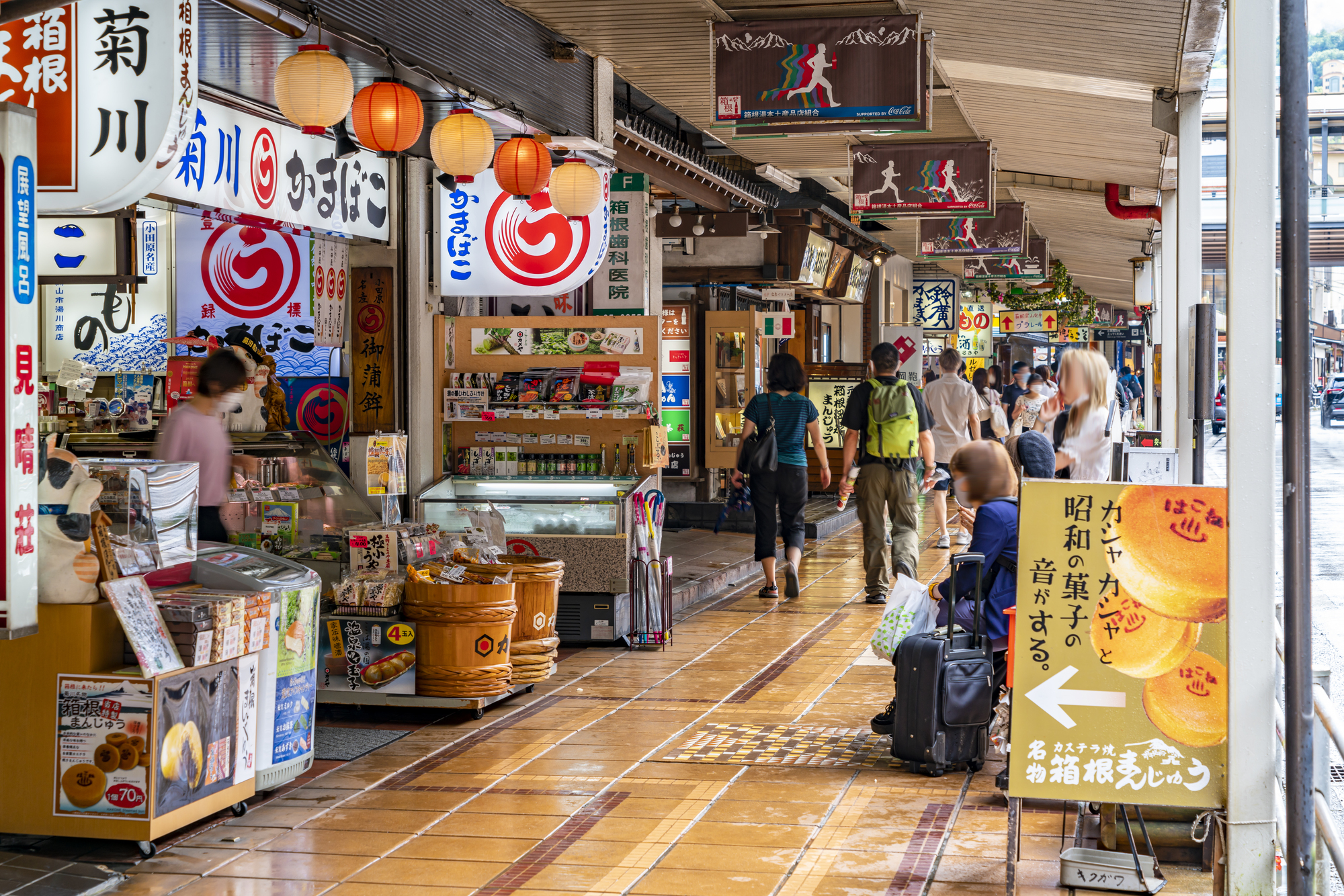
Hakone-Yumoto, the gateway to Hakone, is a lively hot spring town. The streets in front of the station are lined with souvenir shops and restaurants, making it exciting just to walk around.
Etiquette to Know:
- Street Food Manners: While it's tempting to eat a freshly bought warm onsen manju or fried kamaboko on the spot, it's best to avoid eating while walking as it can bother other pedestrians or stain your clothes. The proper manner is to eat in front of the shop where you bought it or in a designated eating area. Dispose of skewers and wrappers in the shop's trash can or take them with you.
- Walking on Narrow Streets: The shopping streets are narrow and crowded. Avoid walking spread out and be considerate of others.
- Going Out in a Yukata: Yukata are provided at ryokans. It's fine to walk around in a yukata within the ryokan's premises or the immediate onsen town, but it's common to change into regular clothes when taking a train or bus to visit museums or restaurants in other areas.
Miyanoshita & Kowakudani Areas: Conduct at Historic Sites, Art Venues, and Onsen Theme Parks
Miyanoshita has a retro, calm atmosphere, while Kowakudani is fun for the whole family. Here, respect for historic buildings and art, and proper public behavior are required.
Etiquette to Know:
- Behavior at Historic Buildings: In places like the Fujiya Hotel, speak softly and avoid running around. Feel the weight of history quietly. Do not touch old furniture or fixtures unnecessarily.
- Museum Etiquette: Even with outdoor exhibits, do not touch the artworks (unless permitted). Always check the rules for photography at each facility. Flash photography is almost always prohibited as it can damage the works.
- Rules at Yunessun: The "Yunessun" area (swimsuits) and the "Mori no Yu" area (no clothes) are clearly separated. Check the rules carefully.
Gora & Sengokuhara Areas: Quietly Enjoying Grand Nature and Art
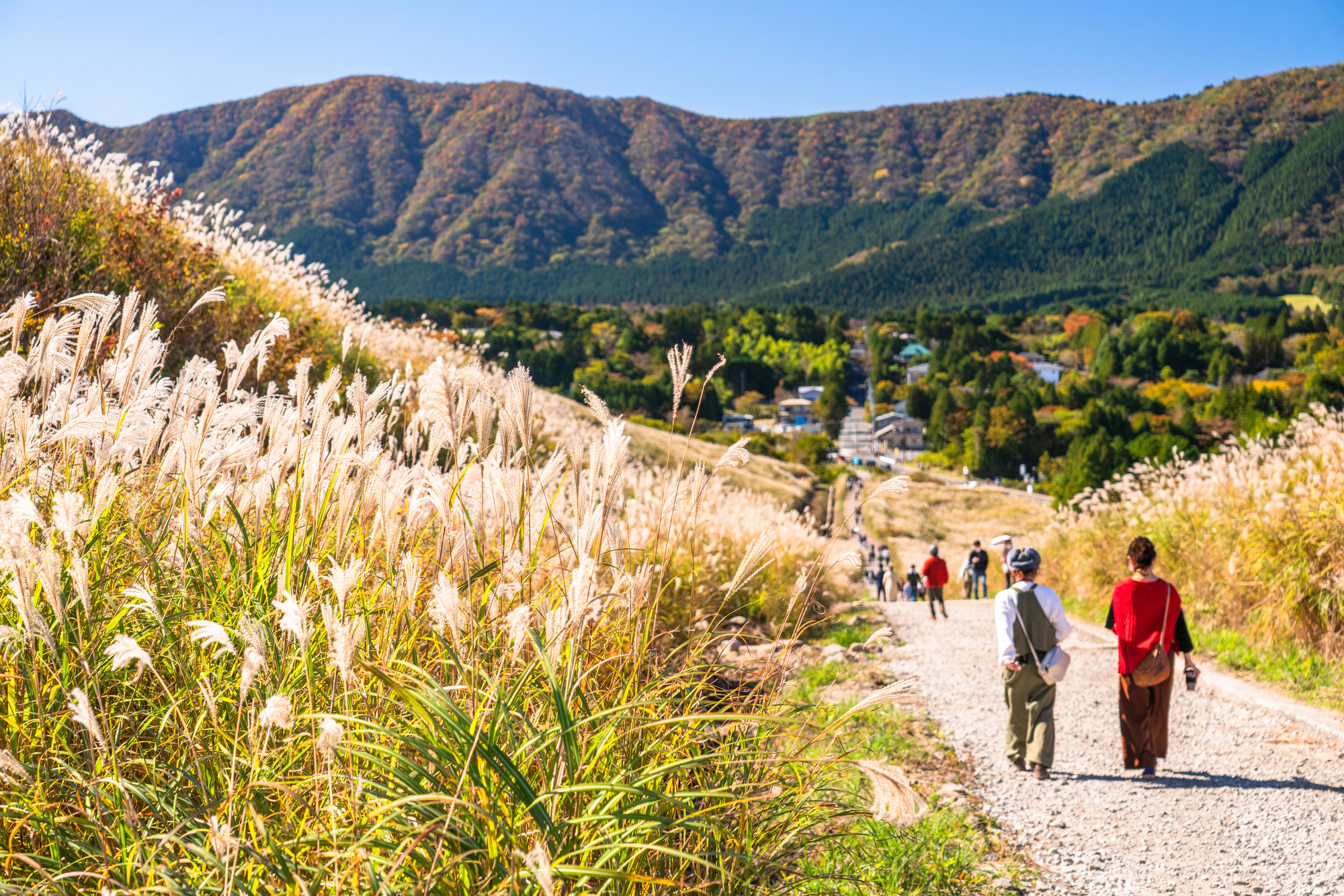
Gora is a sophisticated resort area, and Sengokuhara is known for its vast pampas grass fields. Consideration for the natural environment is especially important here.
Etiquette to Know:
- Respect for Nature: When walking through the pampas grass fields or parks, always stay on the designated paths. It is strictly forbidden to cross ropes and enter the vegetation to protect it.
- Enjoying the Quiet Environment: The tranquility of these areas is part of their charm. Refrain from loud conversations and listen to the sounds of nature.
- Take Your Trash Home: To maintain the beautiful scenery, there are very few trash cans in Hakone. It's a rule to take your own trash back with you.
Lake Ashi & Moto-Hakone Areas: Behavior at Sacred Places and Scenic Spots
The Lake Ashi area is a highlight of Hakone tourism, featuring stunning views of Mt. Fuji, a solemn shrine, and the volcanic activity of Owakudani.
Etiquette to Know:
- Consideration on Transport: On the pirate ship or ropeway, don't monopolize the best spots by the windows or on the deck. Share the view with other passengers.
- How to Pray at a Shrine: Hakone Shrine is a sacred place. Cleanse your hands and mouth at the chozuya (water pavilion), and the basic manner of praying at the main hall is "two bows, two claps, one bow."
- Precautions at Owakudani: Owakudani is an active volcanic area. Those with asthma, bronchial conditions, heart disease, or who are pregnant may have restricted access due to health concerns. Always follow the signs and instructions from staff.
4.The Essentials: A Themed Guide to Manners for Enjoying Hakone
4-1. Onsen Edition: A Complete Guide to Japan's "Bathing Culture" (Including Tattoos)
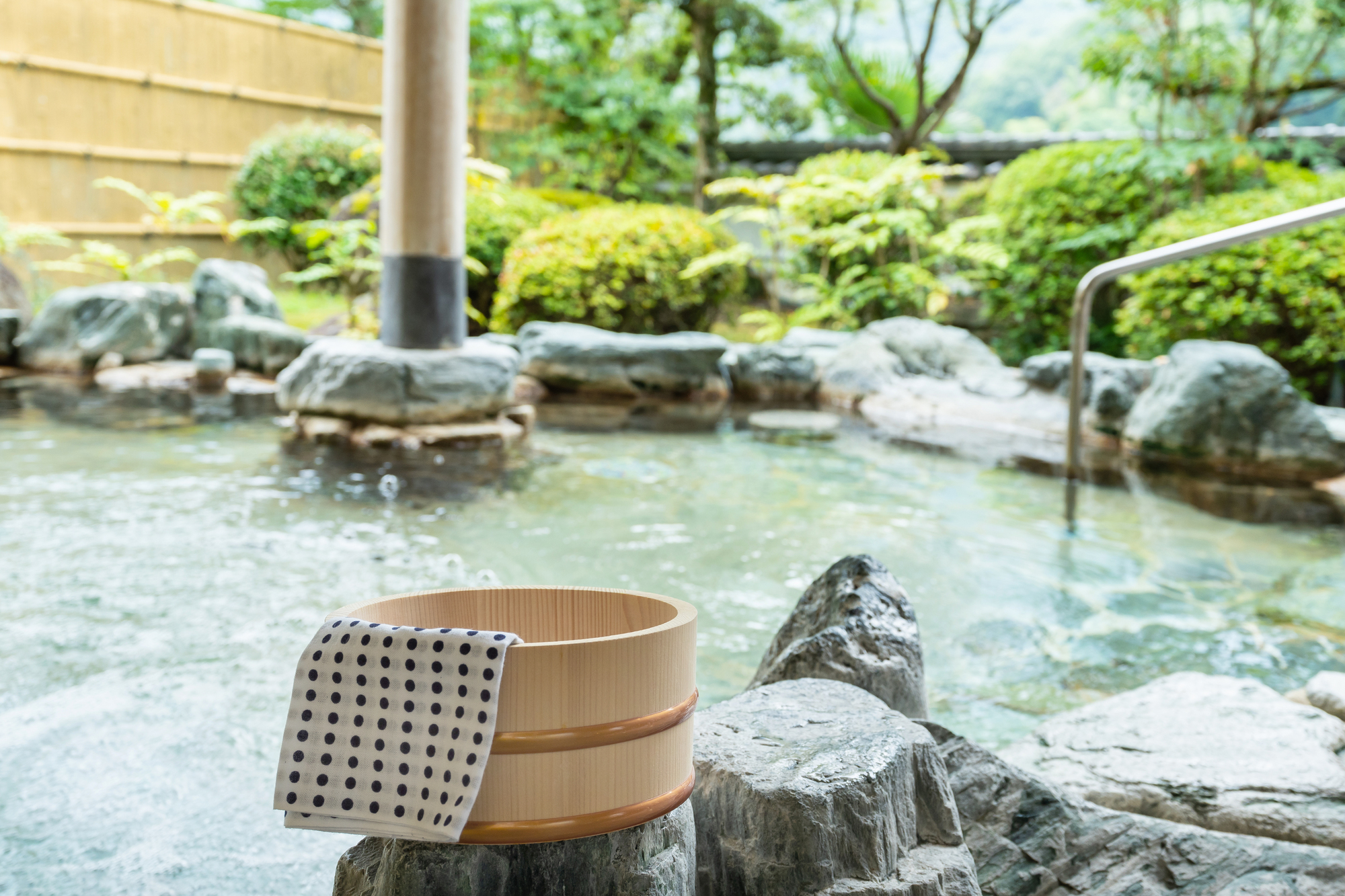
Onsen (hot springs) are one of the greatest pleasures of a trip to Hakone, but they are special places for the Japanese and have unique rules.
- Before Bathing: Undress completely in the changing room. Take a large and small towel to the bathing area.
- Kakeyu (Pre-rinse): Before entering the bathtub, be sure to rinse your body's dirt off at the "washing area." Ideally, wash your whole body with a shower.
- Be Quiet in the Bathtub: The bathtub is a place for relaxation. No swimming or loud talking.
- Keep Your Towel Out of the Water: For hygiene reasons, do not put your large or small towel in the bathtub. It's common to place the small towel on your head or beside the tub.
- About Tattoos: In Japan, many facilities still prohibit people with tattoos from entering public baths due to historical reasons. Consider options like using a private onsen (kashikiri-buro), finding tattoo-friendly facilities in advance, or choosing a room with a private onsen bath.
4-2. Dining Edition: Table Manners to Enrich Your Delicious Experience
- Dining at a Ryokan: It's common to wear a yukata for dinner, enjoying the meal in a relaxed atmosphere.
- How to Use Hashi (Chopsticks): Avoid "sashi-bashi" (stabbing food), "mayoi-bashi" (hovering over dishes), and other taboos.
- Handling Bowls: It's proper manner to lift small bowls, like rice bowls and soup bowls, to eat from them.
4-3. Transportation Edition: For Smooth and Comfortable Travel
- Waiting to Board: Line up in the designated area when waiting for a train or bus. Let people get off first.
- Behavior Onboard: Refrain from loud conversations and phone calls. Hold your backpack in front of you or place it at your feet.
4-4. Nature & Environment Edition: To Preserve Beautiful Hakone for the Future
Most of Hakone is designated as Fuji-Hakone-Izu National Park.
- Zero-Trash Mindset: Having the mindset of "leave it more beautiful than you found it" helps protect this wonderful nature.
- Consideration for Wildlife: Even if you encounter wild monkeys or boars, never feed them.
- Use of Drones: Flying drones in national parks is strictly regulated. Always check the rules before flying.
5.Trip Planning: Model Courses to Practice Good Manners
5-1.[1-Night, 2-Day] Hakone Golden Route Classic Course
- Day 1: Romancecar from Shinjuku to Hakone-Yumoto → Stroll through Yumoto shopping street → Hakone Tozan Railway to Gora → Explore Gora Park → Check into a ryokan in Gora → Enjoy the onsen following proper manners.
- Day 2: From Gora, take the cable car and ropeway to Owakudani → Ropeway to Togendai → Board the Hakone Sightseeing Cruise on Lake Ashi → Get off at Moto-Hakone Port and visit Hakone Shrine → Bus to Odawara or Hakone-Yumoto Station → Head home.
5-2. [2-Night, 3-Day] Deep Dive into Art and Nature Course
- Day 1: Bus from Tokyo to Sengokuhara → Admire art at the Pola Museum of Art → Walk through the pampas grass fields → Stay at a hotel in the Sengokuhara area.
- Day 2: Travel by bus to enjoy the Hakone Open-Air Museum → Move to Miyanoshita for lunch or coffee at the Fujiya Hotel → Go to Gora to be soothed by the moss garden at the Hakone Museum of Art → Stay at a ryokan in Gora.
- Day 3: Follow the Golden Route (Owakudani → Lake Ashi) similar to Day 2 of the classic course → Souvenir shopping in Hakone-Yumoto → Head home.
Taking Home the Best Memories
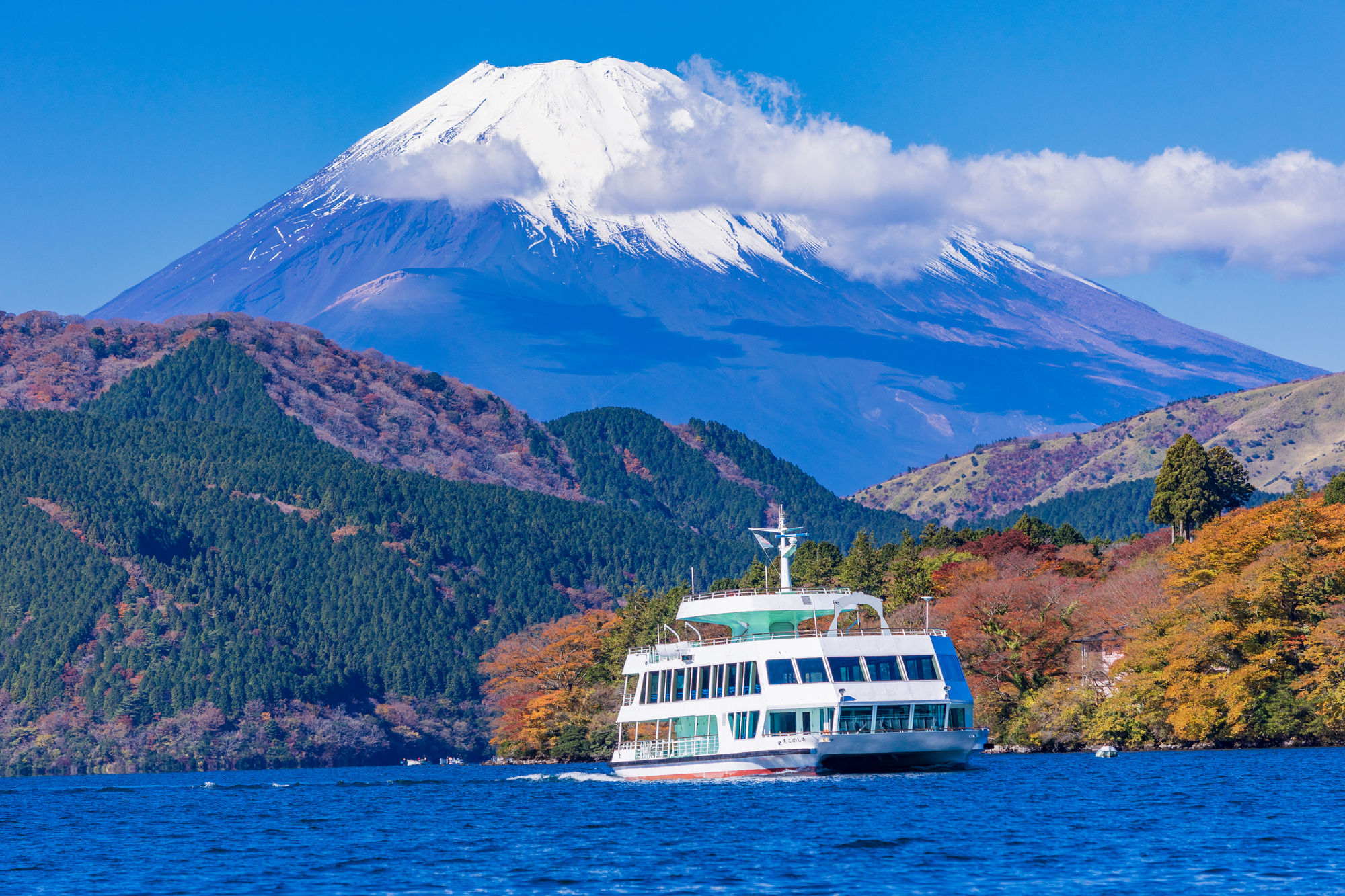
The many manners and rules introduced in this guide are not meant to restrict you. Rather, they are an expression of the "consideration for others" and "respect for nature" that the Japanese people value.
By being just a little conscious of these considerations, you will be welcomed warmly by the locals not just as a "tourist," but as a "good traveler" who respects the local culture. This will surely make your experience in Hakone many times deeper and more valuable.
May you have the best trip, filled with beautiful scenery, comfortable hot springs, and the kindness of people. Please make many unforgettable memories in Hakone.

